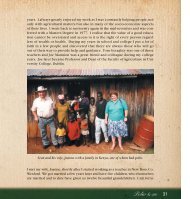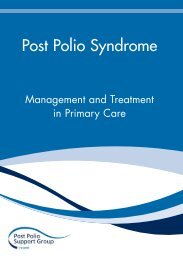Post Polio Syndrome - Management & Treatment in Primary
Post Polio Syndrome - Management & Treatment in Primary
Post Polio Syndrome - Management & Treatment in Primary
Create successful ePaper yourself
Turn your PDF publications into a flip-book with our unique Google optimized e-Paper software.
2 <strong>Post</strong> <strong>Polio</strong> <strong>Syndrome</strong><br />
Acute Paralytic <strong>Polio</strong><br />
It is not known why some patients developed sp<strong>in</strong>al polio while others<br />
suffered a flu-like illness with no neurological sequelae. 2<br />
Acute sp<strong>in</strong>al polio is characterised by asymmetric paralysis of muscles<br />
served by motor units orig<strong>in</strong>at<strong>in</strong>g <strong>in</strong> sp<strong>in</strong>al cord anterior horn cells which<br />
have been damaged or killed by the polio virus. This paralysis is often<br />
very sudden and sometimes very severe, usually <strong>in</strong>volv<strong>in</strong>g the lower<br />
limbs and is often maximal after 48 hours. There is also a bulbar form of<br />
acute polio which causes paralysis of respiratory muscles and those of<br />
deglutition; this had a particularly high mortality and frequently required<br />
ventilation (tracheostomy and positive pressure ventilation or negative<br />
pressure ventilation, e.g. the body encas<strong>in</strong>g “iron lung”).<br />
Dur<strong>in</strong>g the acute phase of polio, strict bed rest was sometimes used to<br />
prevent further spread of paralysis.<br />
Summary of neurological effects of acute polio:<br />
● Sp<strong>in</strong>al polio due to damaged or killed anterior horn cells,<br />
● Acute paralysis of groups of muscles <strong>in</strong> limbs, or<br />
● Respiratory muscles <strong>in</strong> acute bulbar polio lead<strong>in</strong>g to:<br />
– Respiratory failure.<br />
– Dysphagia.<br />
– Speech difficulties.<br />
Recovery Phase<br />
The recovery phase of polio requires that “orphaned” muscle fibres<br />
become re-<strong>in</strong>nervated by axon sprouts and large numbers of hypertrophied<br />
muscle fibres may be <strong>in</strong>nervated by small numbers of overworked<br />
surviv<strong>in</strong>g neurons. Some muscle fibres and groups of muscles may never<br />
be re-<strong>in</strong>nervated and the rema<strong>in</strong><strong>in</strong>g muscle groups will compensate by<br />
hypertrophy<strong>in</strong>g and work<strong>in</strong>g very much harder.<br />
Patients underwent physiotherapy and mobilisation with stretch<strong>in</strong>g<br />
and sometimes spl<strong>in</strong>t<strong>in</strong>g of affected limbs. This was to retra<strong>in</strong> affected<br />
muscles and help rega<strong>in</strong> function. Orthoses were sometimes used to help<br />
PPS Mngt and Treat.<strong>in</strong>db 2 02/07/2007 16:07:48





